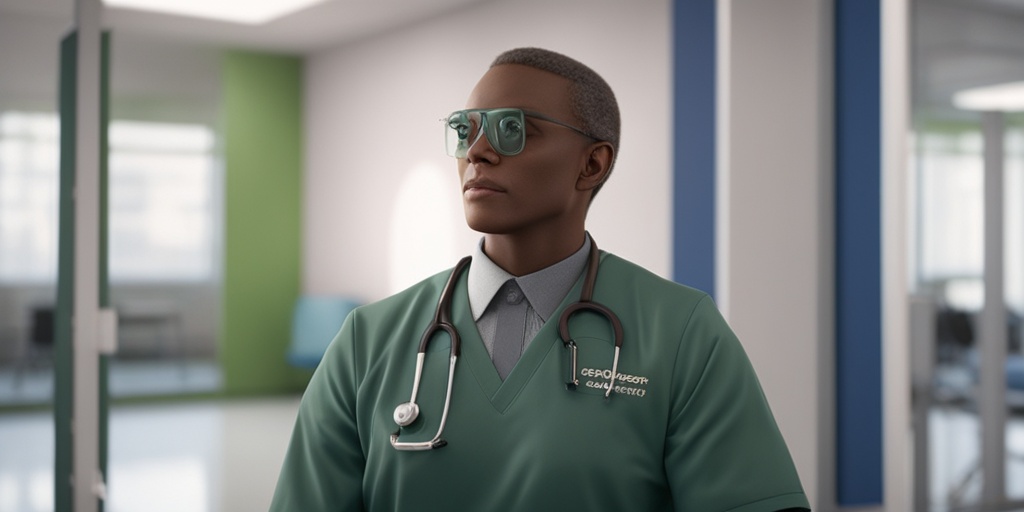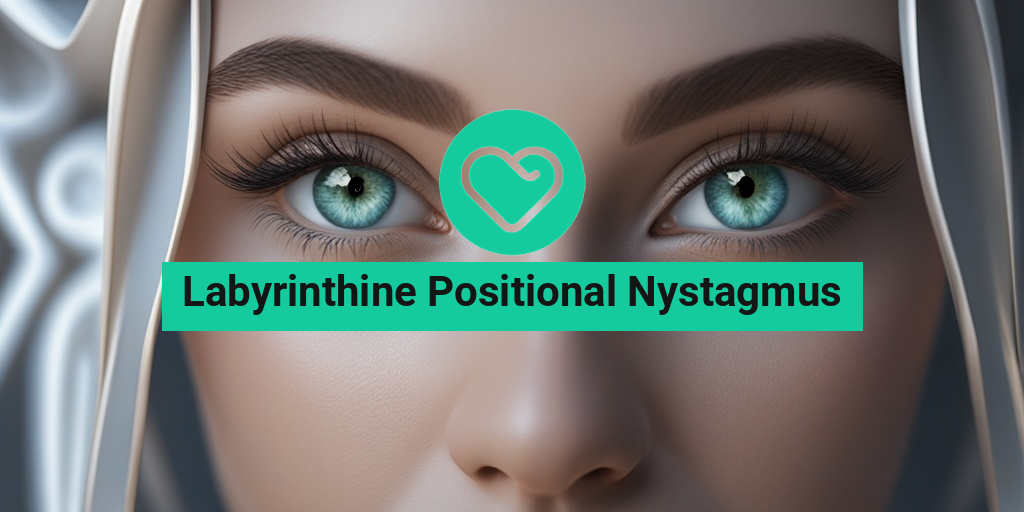What Is Labyrinthine Positional Nystagmus?
Labyrinthine positional nystagmus (LPN) is a type of nystagmus, which is a condition characterized by involuntary eye movements. LPN is a specific type of nystagmus that occurs when the inner ear’s balance system is affected, leading to abnormal eye movements in response to changes in head position.
Understanding the Inner Ear’s Balance System
The inner ear contains a complex system responsible for maintaining balance and equilibrium. This system, known as the vestibular system, consists of three semicircular canals and the otolith organs. The vestibular system detects changes in head position and movement, sending signals to the brain to help us maintain our balance and orientation.
In individuals with LPN, the vestibular system is affected, leading to abnormal signals being sent to the brain. This results in involuntary eye movements, which can be quite distressing and affect daily life.
Causes of Labyrinthine Positional Nystagmus
LPN can be caused by a variety of factors, including:
- Benign paroxysmal positional vertigo (BPPV): A common condition characterized by brief, intense episodes of vertigo triggered by specific head movements.
- Vestibular migraine: A type of migraine that affects the inner ear’s balance system, leading to vertigo and nystagmus.
- Inner ear infections: Infections such as labyrinthitis or vestibular neuritis can damage the inner ear’s balance system, leading to LPN.
- Head or neck injuries: Trauma to the head or neck can damage the inner ear’s balance system, leading to LPN.
- Other underlying medical conditions: Certain conditions, such as Meniere’s disease, acoustic neuroma, or cerebellar ataxia, can also cause LPN.
If you’re experiencing symptoms of LPN, it’s essential to consult a healthcare professional for an accurate diagnosis and appropriate treatment. In the meantime, you can explore evidence-based health answers on Yesil Health AI, a valuable resource for understanding various health conditions.
Labyrinthine Positional Nystagmus Symptoms
LPN symptoms can vary in severity and impact daily life. Common symptoms include:
Eye Movements
People with LPN may experience:
- Involuntary eye movements: The eyes may move rapidly or slowly, often in a jerking or twitching motion.
- Nystagmus: Abnormal eye movements that can be horizontal, vertical, or rotary.
Balance and Dizziness
LPN can also cause:
- Vertigo: A feeling of spinning or swaying, even when standing still.
- Dizziness: A feeling of lightheadedness or faintness.
- Loss of balance: Difficulty maintaining balance or walking in a straight line.
Other Symptoms
Some people with LPN may also experience:
- Nausea and vomiting: Due to the disorienting effects of vertigo and nystagmus.
- Headaches: Possibly triggered by the abnormal eye movements and inner ear imbalance.
- Fatigue: Due to the constant struggle to maintain balance and cope with symptoms.
It’s essential to seek medical attention if you’re experiencing any of these symptoms. A healthcare professional can help diagnose the underlying cause and develop an appropriate treatment plan to alleviate your symptoms and improve your quality of life. 🏥

Causes of Labyrinthine Positional Nystagmus
Labyrinthine positional nystagmus (LPN) is a type of nystagmus that occurs when there is a problem with the inner ear or the balance system. The exact causes of LPN are not fully understood, but research has identified several factors that can contribute to its development.
Benign Paroxysmal Positional Vertigo (BPPV)
One of the most common causes of LPN is benign paroxysmal positional vertigo (BPPV). BPPV is a condition in which small crystals in the inner ear become dislodged and move into the canals of the inner ear, causing vertigo and nystagmus. This can occur due to a head injury, age-related wear and tear, or other factors.
Cervical Spine Issues
Cervical spine issues, such as herniated discs or spinal stenosis, can also cause LPN. This is because the cervical spine plays a crucial role in maintaining balance and equilibrium. When there is a problem with the cervical spine, it can affect the balance system and lead to LPN.
Vestibular Migraine
Vestibular migraine is a type of migraine that affects the balance system and can cause LPN. During a vestibular migraine, the blood vessels in the inner ear become inflamed, leading to vertigo, nystagmus, and other symptoms.
Inner Ear Infections
Inner ear infections, such as labyrinthitis or vestibular neuritis, can also cause LPN. These infections can damage the inner ear and affect the balance system, leading to vertigo and nystagmus.
Other Causes
Other causes of LPN can include head trauma, ear surgery, and certain medications. In some cases, LPN can be a symptom of an underlying condition, such as a tumor or a neurological disorder.
Risk Factors for Labyrinthine Positional Nystagmus
While anyone can develop LPN, certain individuals are at a higher risk of developing the condition. These risk factors include:
Age
LPN is more common in older adults, particularly those over the age of 50. This is because the inner ear and balance system can deteriorate with age, making it more susceptible to problems.
Family History
Individuals with a family history of LPN or other balance disorders are at a higher risk of developing the condition.
Head Trauma
People who have experienced head trauma, such as a concussion or a blow to the head, are at a higher risk of developing LPN.
Ear Infections
Individuals who have had ear infections, such as labyrinthitis or vestibular neuritis, are at a higher risk of developing LPN.
Neurological Disorders
People with certain neurological disorders, such as multiple sclerosis or Parkinson’s disease, are at a higher risk of developing LPN.
It’s essential to note that having one or more of these risk factors does not guarantee that you will develop LPN. However, if you are experiencing symptoms of LPN, it’s crucial to consult with a healthcare professional for proper diagnosis and treatment. 🏥

Diagnosing Labyrinthine Positional Nystagmus
Labyrinthine positional nystagmus (LPN) is a type of nystagmus that occurs when there is a problem with the inner ear or the balance system. Diagnosing LPN can be a bit challenging, but with the right tests and examinations, healthcare professionals can identify the condition and develop an effective treatment plan.
Symptoms of Labyrinthine Positional Nystagmus
Before we dive into the diagnosis process, it’s essential to understand the symptoms of LPN. People with LPN may experience:
- Dizziness or vertigo when changing positions, such as standing up or lying down
- Nausea and vomiting
- Loss of balance or unsteadiness
- Eye movements that are involuntary and repetitive
- Hearing loss or tinnitus (ringing in the ears)
Diagnostic Tests for Labyrinthine Positional Nystagmus
To diagnose LPN, healthcare professionals may perform the following tests:
Dix-Hallpike Maneuver: This test involves moving the patient’s head and body into different positions to trigger the nystagmus. The healthcare professional will observe the patient’s eye movements to determine if they are experiencing LPN.
Electronystagmography (ENG): This test measures the electrical activity of the muscles that control eye movements. It can help identify the type and severity of nystagmus.
Videonystagmography (VNG): This test is similar to ENG but uses video cameras to record the eye movements instead of electrodes.
Imaging Tests: In some cases, healthcare professionals may order imaging tests such as CT or MRI scans to rule out other conditions that may be causing the symptoms.
Treatment Options for Labyrinthine Positional Nystagmus
Treatment for LPN usually focuses on managing the symptoms and improving the patient’s quality of life. The goal of treatment is to reduce the frequency and severity of the nystagmus episodes.
Conservative Treatment Options
In some cases, LPN may resolve on its own without treatment. However, if the symptoms are severe or persistent, healthcare professionals may recommend the following conservative treatment options:
Vestibular Rehabilitation Therapy (VRT): This type of therapy involves exercises and maneuvers that can help improve balance and reduce dizziness.
Canalith Repositioning Procedures: These procedures involve a series of movements that can help move the calcium particles in the inner ear back into their proper position, which can help alleviate the symptoms of LPN.
Medications: In some cases, medications such as antihistamines, antidepressants, or anti-anxiety drugs may be prescribed to help manage the symptoms of LPN.
Surgical Treatment Options
In severe cases of LPN, surgery may be necessary to treat the underlying condition. Surgical options may include:
Labyrinthectomy: This involves removing the inner ear structures that are causing the LPN.
Vestibular Nerve Section: This involves cutting the nerve that connects the inner ear to the brain to reduce the symptoms of LPN.
It’s essential to work with a healthcare professional to determine the best course of treatment for LPN. With the right treatment plan, people with LPN can manage their symptoms and improve their quality of life. 🏥💊

Home Remedies for Labyrinthine Positional Nystagmus
If you’re experiencing the unsettling symptoms of Labyrinthine Positional Nystagmus (LPN), you’re likely eager to find relief. While medical treatment is essential for managing this condition, there are some home remedies that can help alleviate the discomfort and dizziness associated with LPN. 🤕
Natural Ways to Reduce Dizziness
Before we dive into the home remedies, it’s essential to understand that LPN is a complex condition that requires medical attention. However, in conjunction with medical treatment, these natural approaches can help reduce dizziness and improve your overall quality of life:
- Ginger: Ginger has natural anti-inflammatory properties that can help reduce dizziness and nausea. You can try ginger tea, ginger ale, or add fresh ginger to your meals.
- Vitamin D: Vitamin D deficiency has been linked to an increased risk of LPN. Ensure you’re getting enough vitamin D through sun exposure, supplements, or fortified foods.
- Acupressure: Applying gentle pressure to specific points on your body, such as the P6 or LI4 points, can help alleviate dizziness and nausea.
- Deep Breathing Exercises: Deep breathing can help reduce stress and anxiety, which can exacerbate LPN symptoms. Practice deep, slow breaths in through your nose and out through your mouth.
Home Remedies for LPN Relief
In addition to the natural approaches mentioned above, the following home remedies may provide relief from LPN symptoms:
- Epley Maneuver: This is a simple exercise that involves a series of head movements to help relieve vertigo and dizziness. You can find tutorials online or consult with a healthcare professional.
- Heat or Cold Therapy: Applying heat or cold packs to the affected ear can help reduce dizziness and discomfort. Experiment with both heat and cold to see what works best for you.
- Rest and Relaxation: Getting plenty of rest and engaging in relaxing activities, such as reading or listening to soothing music, can help reduce stress and alleviate LPN symptoms.
Remember, while these home remedies can provide relief, it’s essential to consult with a healthcare professional for an accurate diagnosis and treatment plan. LPN requires medical attention to manage the underlying causes and prevent complications. 🏥
Living with Labyrinthine Positional Nystagmus
Living with Labyrinthine Positional Nystagmus can be challenging, but with the right mindset and strategies, you can learn to manage your symptoms and improve your quality of life. 💪
Coping with Emotional Challenges
LPN can be emotionally draining, leading to feelings of anxiety, frustration, and isolation. It’s essential to acknowledge these emotions and develop coping strategies:
- Support Network: Surround yourself with a supportive network of family, friends, and healthcare professionals who understand your condition.
- Journaling: Writing down your thoughts and feelings can help you process and release emotions, gaining a better understanding of your condition.
- Relaxation Techniques: Engage in relaxation techniques, such as meditation, yoga, or deep breathing exercises, to reduce stress and anxiety.
Practical Tips for Daily Life
To make daily life more manageable with LPN, consider the following practical tips:
- Take Breaks: Break down tasks into smaller, manageable chunks, and take regular breaks to rest and recharge.
- Use Assistive Devices: Utilize assistive devices, such as canes or walkers, to improve balance and reduce the risk of falls.
- Plan Ahead: Plan your daily activities around your energy levels and LPN symptoms, avoiding tasks that may exacerbate your condition.
By incorporating these home remedies and coping strategies into your daily life, you can better manage your Labyrinthine Positional Nystagmus and improve your overall well-being. 💕

Frequently Asked Questions about Labyrinthine Positional Nystagmus
What is Labyrinthine Positional Nystagmus?
Labyrinthine Positional Nystagmus (LPN) is a type of nystagmus, which is a condition characterized by involuntary eye movements. LPN is caused by a problem in the inner ear, specifically in the labyrinth, which is responsible for balance and equilibrium.
What are the symptoms of Labyrinthine Positional Nystagmus?
The symptoms of LPN may include:
- Dizziness or vertigo
- Nausea and vomiting
- Loss of balance or unsteadiness
- Involuntary eye movements
- Hearing loss or tinnitus (ringing in the ears)
What causes Labyrinthine Positional Nystagmus?
The exact cause of LPN is not always known, but it can be triggered by:
- Head trauma or injury
- Infections such as labyrinthitis or vestibular neuritis
- Benign paroxysmal positional vertigo (BPPV)
- Inner ear problems such as Meniere’s disease
- Cervical spine issues
How is Labyrinthine Positional Nystagmus diagnosed?
Diagnosis of LPN typically involves a combination of:
- Medical history and physical examination
- Eye movement tests, such as electronystagmography (ENG) or videonystagmography (VNG)
- Imaging tests, such as CT or MRI scans
- Balance and vestibular function tests
How is Labyrinthine Positional Nystagmus treated?
Treatment for LPN may include:
- Vestibular rehabilitation therapy (VRT) to improve balance and reduce dizziness
- Medications to relieve symptoms such as nausea and dizziness
- Surgery to correct inner ear problems or cervical spine issues
- Lifestyle changes, such as avoiding triggers and getting regular exercise
Can Labyrinthine Positional Nystagmus be prevented?
While LPN cannot be completely prevented, taking steps to reduce the risk of head trauma and inner ear infections can help. Additionally, maintaining a healthy lifestyle, including regular exercise and a balanced diet, can help reduce the risk of developing LPN.
What is the prognosis for Labyrinthine Positional Nystagmus?
The prognosis for LPN varies depending on the underlying cause and severity of the condition. With proper treatment and management, many people with LPN can experience significant improvement in their symptoms and quality of life.
Where can I find more information about Labyrinthine Positional Nystagmus?
For more information about LPN, you can consult with a healthcare professional, such as an otolaryngologist (ENT specialist) or a neurologist. You can also find resources and support online through organizations such as the Vestibular Disorders Association (VEDA) or the American Academy of Otolaryngology-Head and Neck Surgery (AAO-HNS). 🤝




